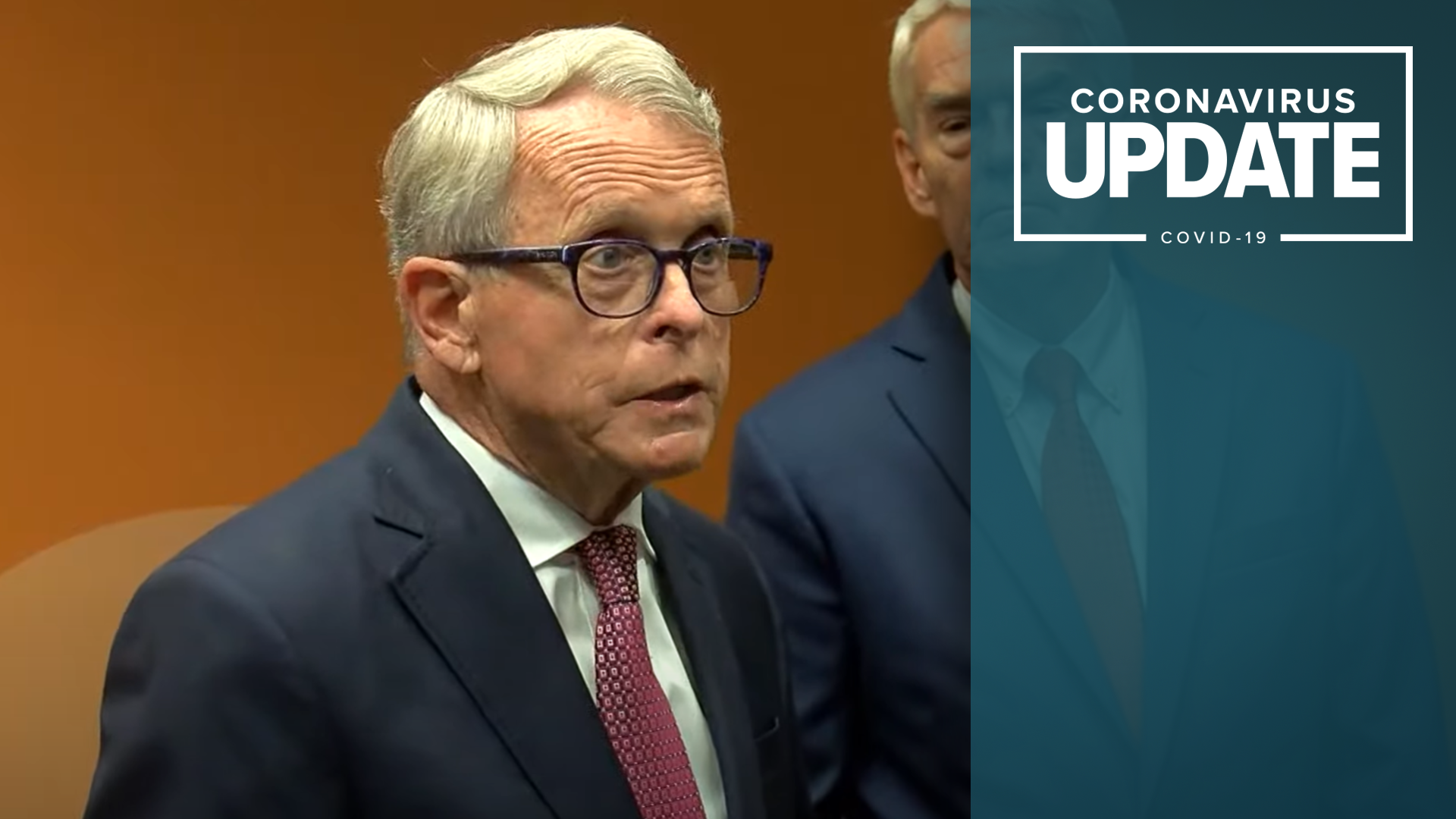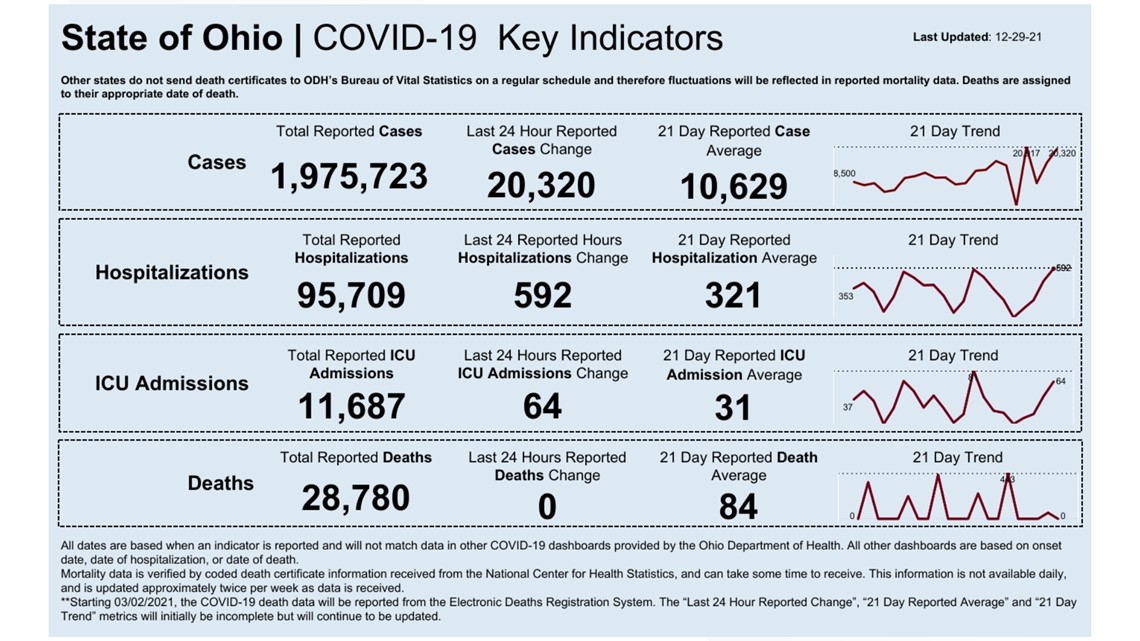'We are tired, we are frustrated' | DeWine mobilizes additional 1,250 members of Ohio National Guard to help with hospital staffing
On Wednesday, the Ohio Department of Health reported 20,320 new cases of COVID-19.

More members of the Ohio National Guard will soon be sent out to hospitals across the state, as the current COVID-19 surge continues to break records.
Ohio Gov. Mike DeWine announced Wednesday that an additional 1,250 troops will be mobilized to help ease the strain staffing shortages are having on health care facilities.
"This is not something that we do lightly," DeWine said, noting that the move requires members of the national guard to pick up and leave their families, jobs and homes.
Major General John C. Harris, Jr. with the Ohio National Guard said that the majority of troops are currently in the Cleveland area, with roughly 460 members of the guard in that region. However, more than 160 people are also here in the Toledo area and another 100 are set up in Columbus. These numbers could fluctuate, however, as the situation changes.
Harris said his team has daily planning meetings to look at the numbers and identify hot spots, giving them the ability to lift and shift resources based on demand. The guard, Harris explained Wednesday, has two missions: to augment medical staff and to augment wraparound services as hospital capacities increase.
A Look into Our Hospitals Medical feel the strain of more patients with fewer staff
Since June 1, when most Ohioans were eligible for the vaccine, 35,962 people have been admitted to the hospital because of COVID-19. Of those patients, DeWine said, 2,687 were fully vaccinated — meaning 92.5% of people in Ohio hospitals with COVID-19 have not received a COVID-19 vaccine.
"It is your choice," DeWine said. "But, the evidence is abundantly clear this is the best way — the best way — to stay out of our hospitals."
The northern part of the state is facing the brunt of the battle. In the zone stretching from Youngstown to Toledo and over to Dover and New Philadelphia, there are currently 3,000 people hospitalized with COVID-19. The Cleveland area saw a new pandemic high, with 1,500. The Cleveland Clinic, in particular, started off the day with 1,000 active COVID-19 patients with 110 of them in the ICU, a first.
Hospitals in the north have already had to postpone elective procedures and may need to make further cuts and bring in workers that aren't generally in clinical care full-time to work with COVID-19 patients.
"The hospital systems are under significant stress in northern Ohio," Dr. Robert Wyllie, chief of medical operations at Cleveland Clinic, said.
But, it's not only the patients coming in with COVID-19 causing a strain, staff members are out because of it.
Wyllie said that nurses and doctors are getting sick with the virus just like everyone else. Currently, the Cleveland Clinic is out 2,700 workers.
A Nurse's Plea "We are tired, we are frustrated."
Clinical care nurse at Riverside Methodist Hospital, Jennifer Hollis, detailed what she sees each day, and the mental impact it has on medical staff as the pandemic rages on.
"It is beyond difficult. Our beds are full. There's nowhere else to go," she said.
Hollis described the constant beeping of ventilators and IV pumps.
"We are so maxed. We are tired, we are frustrated and we want the best for all of our patients," she said.
Hollis said that often medical staff are providing emotional support for families, in addition to clinical care for those sick with the virus.
She made an impassioned plea for Ohioans to get their vaccines and boosters, to avoid going to the ER if you are only seeking a test and if you have symptoms, to just stay home.
"I will continue to fight for you even when you won't fight for yourself," she said.
In the south, Dr. Richard Lofgren, President and CEO of UC Health, said that the state as a whole saw a huge surge with delta. Now, omicron is adding feul to what he called a "raging fire."
"At times I feel like our communities aren't really appreciating what's happening," he said.
Initially, hospitals were scrambling for PPE, then testing, then the vaccine and now it is for qualified staff, as many face burnout and leave the industry entirely.
"I'd be lying if I said I dealt with it well," Hollis said.
COVID-19 Data More than 20,000 new cases reported on Wednesday
On Wednesday, the Ohio Department of Health reported:
- 20,320 new cases of COVID-19, an increase of 4,917 from the day before
- 592 new hospitalizations due to COVID-19, for a total of 5,356 COVID-19 patients currently in the hospital
- 64 new ICU admissions due to COVID-19


The seven-day testing positivity rate reached 24.7% Wednesday, the highest its been since the onset of the pandemic and still nearly five times the CDC threshold of 5%.
The statewide bed occupancy came in at 81.46%.
So far, 6,416,639 Ohioans have been fully vaccinated against the virus, Wednesday alone bringing in 7,517.
Experts estimate that it would take roughly 70-85% of the population to be vaccinated in order to achieve effective herd immunity. As of Wednesday, Ohio came in at 54.89%.
Government Response No orders expected, but more tests could be on the way
DeWine said that in terms of testing, 1.4 million were distributed this December and he plans to continue at that pace, though the state is waiting on new tests to come in.
He noted that the at-home rapid tests often go unreported, but said his team felt that even when people are not reporting, that letting them have that information to make rational choices was most important.
Ohio Department of Health Director Dr. Bruce Vanderhoff said Ohio was one of the first states to prioritize the distribution of at-home test kits, and there has been incredible demand. More than 40,000 Ohioans are getting tested a day.
DeWine said Wednesday that at this point, the state has no plans to mandate masks again or issue any other health orders. However, he did urge students to wear masks in school as a way to keep classes in person and reduce the spread among staff and students alike.


